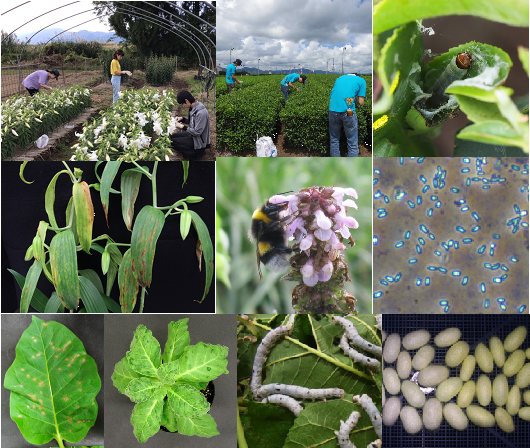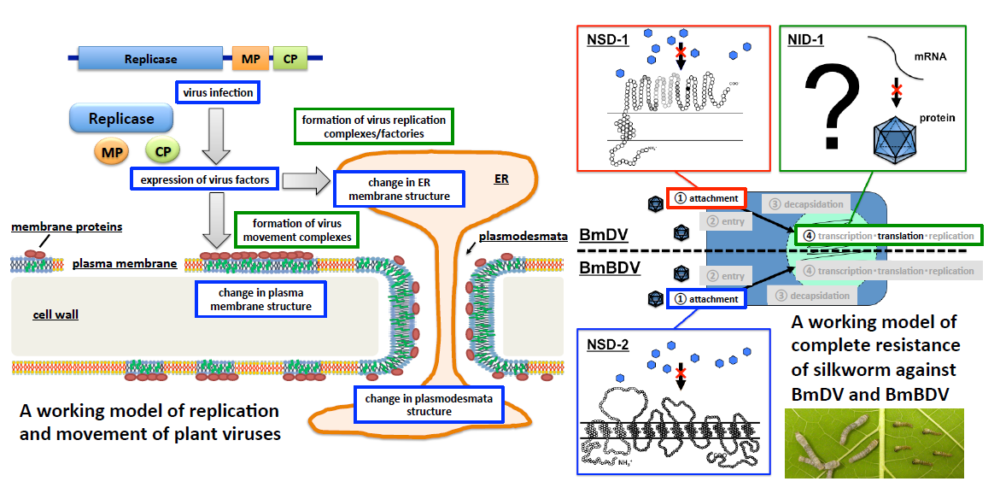Nobumitsu Sasaki
| Position | Associate Professor |
|---|---|
| Affiliation | Institute of Agriculture |
| URL | https://kenkyu-web.tuat.ac.jp/Profiles/12/0001156/profile.html?lang=en |
【LIFE SCIENCE】 Sasaki Team
Parasitism of microbes to plants or insects has various influences on our society. In the field of the agriculture and sericulture business, the parasitism of the microbes often causes diseases, leading to a decrease in amount of production of farm products and the cocoon. On the other hand, the continuous parasitism by the microbe is known to cause the resistance of the host, and the use of such resistance has led to the development of breeding the stably producible cultivars and strains. In addition, many studies to control the outbreak of the periodic pest by using parasitic microbes are ongoing. Our team is trying to elucidate the molecular mechanism of how microbes manipulate their host to enhance parasitic fitness, with the goal of connecting our outputs with technology development for effective pest control and protection of useful organisms.

Studies of the parasitic microbes whose hosts are plants and arthropods including insects are conducted fragmentarily in each research field until now. Our research team consists of researchers of plant pathology and insect pathology and ecology, including international collaborators, Dr. Richard Nelson and Dr. Seth Barribeau, and will try to understand comprehensively the mechanisms of the pathogen infection and host resistance induction under the concept called ” host manipulation of parasitic microbes” across the different fields and, based on our knowledge, develop new biological control applications such as pest control and protection of useful organisms. We will mainly focus on the interaction on the cellular membrane where a pathogen and a host cell directly make contact with each other, and conduct experiments with “visualization of biomolecules by the imaging analysis” and “comprehensive understanding of genome and gene products by omics analyses”.

(1) A study of the mechanism of parasitic plant virus replication and movement through host cell modification
Regarding plant viruses such as Tomato mosaic virus (ToMV) and Plantago asiatica mosaic virus (PlAMV), we will do the screening of factors related to host membranes such as the plasma membrane and the endoplasmic reticulum membranes, which are assumed to be required for formation of their membrane-associated virus replication factories and plasmodesmata-mediated cell-to-cell movement, and further conduct the molecular interaction analysis using the host factors identified.
(2) A study of the molecular mechanism of resistance against parasitic plant viruses
Regarding the virus resistant mediated by the tobacco N gene, we will do experiments to clarify the relationship between the structural alteration of plant membranes and the changes in the expression patterns of genes related to the synthesis of terpenoid-related compounds and also conduct screening and functional analysis of useful plant genes that would be available for strengthening resistance induction against viruses.
(3) A study of the male killing of tea tortrix by symbiosis microbes
“Male killing” is known as a selective fatality of a male arthropod by infection of a symbiosis microbe. In this study using insect partitiviruses and a symbiosis bacterium (Wolbachia) that can cause male killing of Homona magnanima that is an important tea pest, we will identify pathogen genes and proteins that are involved in male killing, and investigate the locations of these pathogens in host cells and tissues in order to clarify the mechanism to cause male killing in infected insects.
(4) An adaptation strategy of nucleopolyhedrovirus in Lymantria dispar
Regarding Lymantria dispar multiple nucleopolyhedrovirus (LdMNPV) that is known to be involved in the cessation the periodic outbreak of Lymantria dispar, we will do experiments to compare pathogenic characters between virus strains, analyze their dynamics in environments and between the hosts, and investigate whether or not LdMNPV genome is integrated in the host genome.
(5) Risk assessment of infection spread by an internal parasitic microbe accompanied with the invasion of alien species Bombus terrestris
Regarding the microsporidium (Nosema bombi) that is assumed to be involved in decrease of bumblebees, we will investigate prevalent rates of the microsporidium in U.K. and Japan using the LAMP method and compare the life cycle traits of isolated N. bombi from infected insects to clarify the evolution of their toxicity.
(6) A study of the mechanism of complete virus resistance of the silkworm
Regarding silkworm membrane proteins known as a determinant for “complete virus resistance” by which the silkworm is immune or symptomless after virus infection, we will identify virus and host factors that interact with these membrane proteins and conduct functional analysis of the factors identified in order to reveal their function as a virus receptor.
(7) Analysis of the Mechanism of Makomotake Formation Induced by Ustilago esculenta Infection
Bamboo shoots (Makomotake in Japanese) are formed by the infection of Ustilago esculenta on Zizania latifolia (Makomo in Japanese), which induces stem enlargement. However, the number and size of Makomodake vary from individual to individual, and stable cultivation has not yet been achieved. In this study, we will isolate the black-ear fungus from Mentha cultivated at our university, clarify the molecular mechanisms involved in the parasitism of the black-ear fungus and stem enlargement, and at the same time, explore methods for stably cultivating Makomotake.


| Position | Associate Professor |
|---|---|
| Affiliation | Institute of Agriculture |
| URL | https://kenkyu-web.tuat.ac.jp/Profiles/12/0001156/profile.html?lang=en |

| Affiliation | Oklahoma State University (U.S.A.) |
|---|---|
| Division / Department | Department of Entomology and Plant Pathology |
| Position | Adjunct Professor |
| URL | - |

| Affiliation | University of Liverpool (U.K.) |
|---|---|
| Division / Department | Institute of Integrative Biology |
| Position | Lecturer |
| URL | https://www.liverpool.ac.uk/integrative-biology/staff/seth-barribeau/ |
Maki INOUE (Institute of Agriculture / Professor)
Katsuhiko ITO (Institute of Agriculture / Associate Professor)
Ken KOMATSU (Institute of Agriculture / Associate Professor)
このページの上部へ